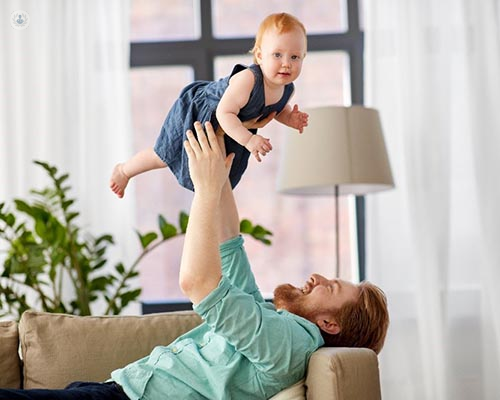Hydronephrosis - information for parents
Written in association with:If we take the word hydronephrosis and break it up, we get the words ‘hydro’, which stands for water, and ‘nephron’, which stands for kidney cells. Each of us has a water bag in the kidneys where filtered urine collects before it is drained into the bladder. Hydronephrosis means ‘excessive water/urine collection in the kidneys’. Hence, it’s a condition where urine cannot drain out of the kidneys properly, causing them to swell up or stretch. It can affect one or both kidneys.
Dr Kishor Tewary, consultant paediatrician, with a special interest in uro-nephrology tells us more about hydronephrosis in children.

Around 1% of pregnancies can have ‘antenatal hydronephrosis’ (which translates as hydronephrosis before birth). This is usually not serious and most cases of hydronephrosis will resolve in a few months after birth, however, a small number of babies may need acute or long-term management and monitoring.
What causes hydronephrosis?
Normally, urine drains from the kidney, down the ureter and into the bladder where it accumulates before being excreted. When too much urine accumulates this is termed hydronephrosis.
Hydronephrosis is caused by either:
- A refluxing ureter; the kidney tube (ureter) that moves urine from the kidneys to the bladder is backwashing urine back into the ureter or kidneys while urinating, due to an impaired flap valve.
- An obstruction (partial/complete) in the outflow tract. This means that there is a blockage somewhere in the bladder, kidney or linking tubes that prevents urine from leaving the kidney.
- A PUJ (pelvic ureteric junction) obstruction is quite rare, affecting 1 in 1,500 children and occurs where the renal pelvis meets the ureter. Sometimes the ureter is too narrow to allow urine to pass from the renal pelvis and this causes an obstruction. An obstruction can happen in babies if the urinary system develops incorrectly before birth. A VUJ obstruction occurs at the vesicoureteric junction, where the ureter connects to the bladder.
What are the symptoms of a blocked kidney?
A blocked kidney is usually asymptomatic in babies and children and only picked up at a routine antenatal scan, or as an incidental finding at a later stage.
Occasionally, it can present as a unilateral/bilateral abdominal lump, accompanied with pain. Other symptoms may include UTI’s, blood in the urine, fever, lack of energy and not feeding well.
How is hydronephrosis diagnosed?
It is commonly picked up on a routine antenatal ultrasound scan, as mentioned before, but the most reliable diagnosis is measuring the width of the renal pelvis diameter.
For a new-born or infant, an anteroposterior diameter (APD) size of up to 7mm is accepted as normal, while in older infants and children, 10mm is accepted. If the APD size exceeds this measurement, it means that hydronephrosis is causing dilation of the kidneys.
How is hydronephrosis treated?
The treatment depends on the cause of hydronephrosis. This is established using imaging techniques, including an ultrasound of the kidneys, and /or special X-rays using dye to show the excretion of urine.
If the cause is a refluxing ureter (VUR):
If the reflux is mild to moderate, the child is given low dose antibiotics to take at night. These will be taken until the child reaches an age where they have achieved full bladder continence. This not only prevents them from getting a urinary tract infection (which can cause kidney scarring in the presence of reflux), but also lets the child achieve full bladder control.
For severe reflux, surgeons recommend a ‘ureteric re-implantation’. This involves repositioning the ureter (kidney tube) in the bladder at a deeper level to make a better flap valve. Newer techniques involve the injection of a spongy material at the insertion of the ureter into the bladder to improve the flap valve mechanism and prevent reflux.
A partial PUJ obstruction improves with age in the majority of cases. However, this needs to be monitored until it is fully resolved. A complete obstruction at the PUJ, VUJ or the bladder outlet needs surgical management.
If treated early, hydronephrosis will not usually cause any long-lasting medical problems.
Make a consultation with Dr Kishor Tewary if you are concerned that your baby or child has symptoms and be sure to attend any necessary scans and tests to catch any abnormalities from an early stage.


